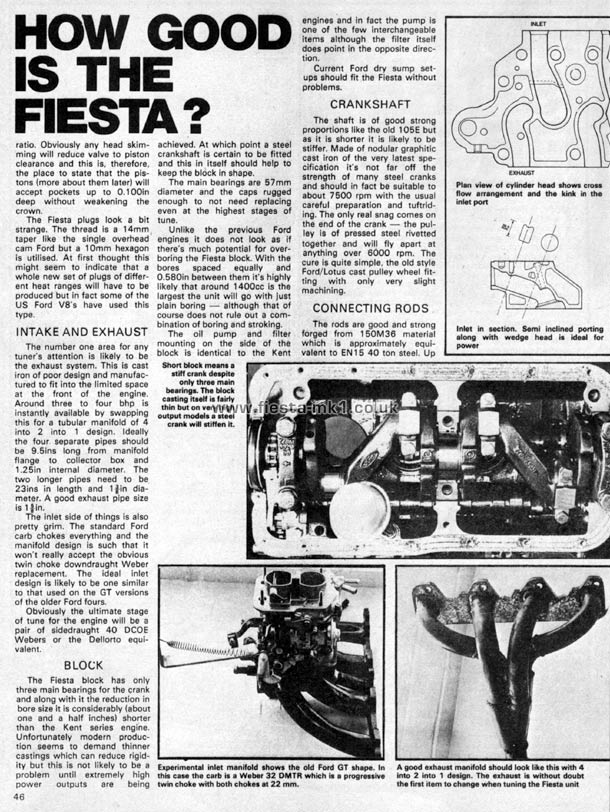Copy of Article Text Below
.....ratio. Obviously any head skimming will reduce valve to piston clearance and this is, therefore, the place to state that the pistons (more about them later) will accept pockets up to O.IOOin deep without weakening the crown.
The Fiesta plugs look a bit strange. The thread is a 14mm, taper like the single overhead cam Ford but a 10mm hexagon is utilised. At first thought this might seem to indicate that a whole new set of plugs of different heat ranges will have to be produced but in fact some of the US Ford V8's have used this type.
INTAKE AND EXHAUST
The number one area for any tuner's attention is likely to be the exhaust system. This is cast iron of poor design and manufactured to fit into the limited space at the front of the engine. Around three to four bhp is instantly available by swapping this for a tubular manifold of 4 into 2 into 1 design. Ideally the four separate pipes should be 9.Sins long from manifold flange to collector box and 1.25in internal diameter. The two longer pipes need to be 23ins in length and 1fin diameter. A good exhaust pipe size is If in.
The inlet side of things is also pretty grim. The standard Ford carb chokes everything and the manifold design is such that it won't really accept the obvious twin choke downdraught Weber replacement. The ideal inlet design is likely to be one similar to that used on the GT versions of the older Ford fours.
Obviously the ultimate stage of tune for the engine will be a pair of sidedraught 40 DCOE Webers or the Dellorto equivalent.
BLOCK
The Fiesta block has only three main bearings for the crank and along with it the reduction in bore size it is considerably (about one and a half inches) shorter than the Kent series engine. Unfortunately modern production seems to demand thinner castings which can reduce rigidity but this is not likely to be a problem until extremely high power outputs are being achieved. At which point a steel crankshaft is certain to be fitted and this in itself should help to keep the block in shape.
The main bearings are 57mm diameter and the caps rugged enough to not need replacing even at the highest stages of tune.
Unlike the previous Ford engines it does not look as if there's much potential for over-boring the Fiesta block. With the bores spaced equally and 0.580in between them it's highly likely that around 1400cc is the largest the unit will go with just plain boring - although that of course does not rule out a combination of boring and stroking.
The oil pump and filter mounting on the side of the block is identical to the Kent engines and in fact the pump is one of the few interchangeable items although the filter itself does point in the opposite direction.
Current Ford dry sump setups should fit the Fiesta without problems.
CRANKSHAFT
The shaft is of good strong proportions like the old 105E but as it is shorter it is likely to be stiffen Made of nodular graphitic cast iron of the very latest specification it's not far off the strength of many steel cranks and should in fact be suitable to about 7500 rpm with the usual careful preparation and tuftrid-ing. The only real snag comes on the end of the crank - the pulley is of pressed steel rivetted together and will fly apart at anything over 6000 rpm. The cure is quite simple, the old style Ford/Lotus cast pulley wheel fitting with only very slight machining.
CONNECTING RODS
The rods are good and strong forged from 150M36 material which is approximately equivalent to EN15 40 ton steel. Up.....
Captions -
Top-Right - Plan view of cylinder head shows cross flow arrangement and the kink in the inlet port
Middle - Short block means a stiff crank despite only three main bearings. The block casting itself is fairly thin but on very high output models a steel crank will stiffen it.
Middle-Right - Inlet in section. Semi inclined porting along with wedge head is ideal for power
Bottom-Middle - Experimental inlet manifold shows the old Ford GT shape. In this case the carb is a Weber 32 DMTR which is a progressive twin choke with both chokes at 22 mm.
Bottom-Right - A good exhaust manifold should look like this with 4 into 2 into 1 design. The exhaust is without doubt the first item to change when tuning the Fiesta unit
|




